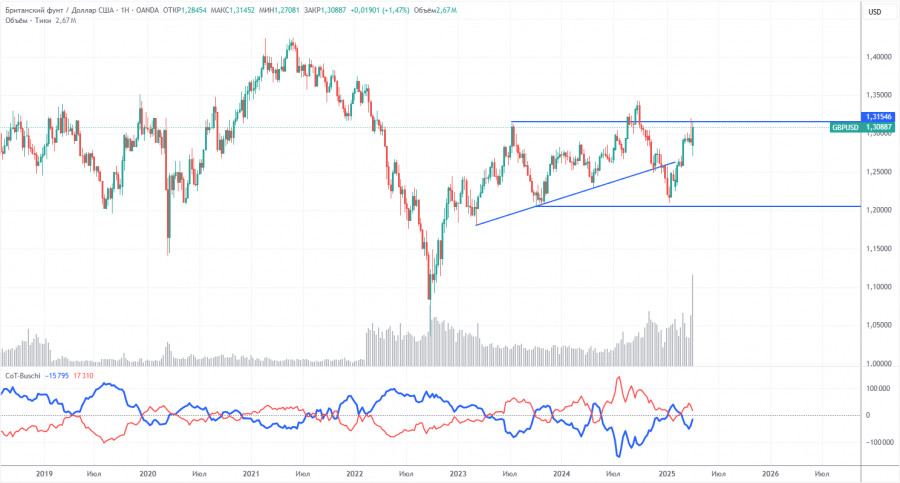

The GBP/USD currency pair continued trading higher on Friday, although the dollar avoided substantial losses this time. Even though one day without a complete dollar collapse may seem significant, it does not alter the larger perspective. As long as Donald Trump continues to escalate global tensions, there is little hope for the dollar. Of course, we must remember that we are dealing with Trump. At any moment, the U.S. President could cancel all tariffs, declare victory, and end the conflict. Perhaps only China would be spared such a turnaround. At the same time, Trump could just as easily escalate the trade war even further.
Unfortunately, it's impossible to predict Trump's actions. Forecasting Trump's behavior may be the most impossible task. And since all market movements now depend on Trump, they're just as unpredictable. On Friday, alongside the surprising news of a tariff hike on China to an astounding 145%, the UK also released reports on industrial production and GDP. While these aren't the most crucial data points (especially now), they still supported the British pound. Meanwhile, the dollar continues to hit new lows almost daily.
Many trading signals were generated on Friday, but most were imprecise and random. The market is currently experiencing very strong movements, which is why so many signals appear. However, these signals aren't forming due to strong levels or technical setups but rather due to chaotic news flow and erratic price action. The first signal on Friday near the 1.2981–1.2987 zone was truly notable—after that, it turned into a rollercoaster.

COT (Commitments of Traders) reports on the British pound show that commercial traders' sentiment has constantly shifted in recent years. The red and blue lines, representing net positions of commercial and non-commercial traders, frequently cross and often stay close to the zero line. They're also close together, suggesting a roughly equal balance between long and short positions.
On the weekly time frame, the price initially broke through the 1.3154 level, then breached the trendline, returned to 1.3154, and bounced off. Breaking the trendline suggests the pound is likely to continue declining, and the bounce off 1.3154 increases the chances of this bearish scenario. On the weekly chart, everything again points to the pound preparing for a downward move.
According to the latest COT report on the British pound, the "non-commercial" group closed 13,200 BUY contracts and opened 4,000 SELL contracts. This means the net position of non-commercial traders has declined for the second week, this time by 17,200 contracts.
The fundamental backdrop still offers no justification for long-term pound purchases, and the currency remains at real risk of continuing a global downtrend. The pound has gained significantly lately, but the sole reason is Donald Trump's trade policy.

In the hourly time frame, the GBP/USD pair showed a massive rally following nearly a month-long flat phase, then suffered a sharp decline, and is now rising again. However, this renewed strength has little to do with the pound itself—it reflects the falling U.S. dollar triggered by Trump's actions. Chaos, panic, and uncertainty still dominate the market, which should be considered when opening positions.
For April 14, we highlight the following important levels: 1,2511, 1,2605-1,2620, 1,2691-1,2701, 1,2796-1,2816, 1,2863, 1,2981-1,2987, 1,3050, 1,3119, 1,3175, 1,3222, 1,3273, 1,3358. Senkou Span B (1.2956) and Kijun-sen (1.2925) lines can also be sources of signals. These Ichimoku indicator lines may shift during the day and should be adjusted accordingly. Stop loss orders should be set to break even once the price moves 20 pips in the correct direction. This helps protect against potential losses if the signal turns out to be false.
No crucial reports or events are scheduled for Monday in the UK or the U.S., but Trump-related news could emerge anytime. Soon, we might see actual trade negotiations with some countries, which could ease market tensions and help the dollar recover—at least slightly. It's safe to say that no one denies how much the U.S. currency has lost in recent months.